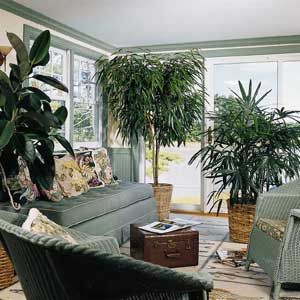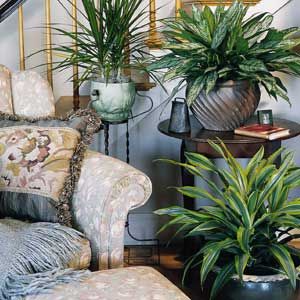If you’re struggling with keeping the greenery inside your home alive and well, you’re not the only one. Success with houseplants requires understanding their basic needs and choosing the right plants for your space. This guide will help you select the best low-maintenance plants that thrive in different conditions, with essential care tips for any plant you bring home.
Understanding the Basics of Houseplant Care
Before looking at specific plant recommendations, you want to know the fundamental needs of houseplants. These include proper light, water, temperature, and humidity levels. By understanding these elements, you’ll be better able to care for any plant you bring home.
Light Requirements
Light is the most important factor for indoor plants. Different plants have different light needs, from bright direct sunlight to low indirect light. Deborah Brown, a University of Minnesota extension horticulturist, explains, “Light is clearly the most limiting factor to growing plants indoors. All plants need light to manufacture food, but the amount needed varies from one plant to another.”
To determine the light levels in your home, see how sunlight moves through your space throughout the day. South-facing windows typically provide the most light, while north-facing windows offer the least. East- and west-facing windows provide moderate sunlight levels.
Watering Needs
Proper watering is essential for your plant’s health. Overwatering is one of the most common mistakes new plant owners make. Generally, it’s better to underwater than overwater. Most houseplants prefer to dry out slightly between waterings.
When you water, do so thoroughly. Use room temperature water and continue until excess flows from the drainage holes. Always empty the saucer beneath the pot to prevent the plant from sitting in water, which can lead to root rot.
Temperature and Humidity
Most houseplants grow well in temperatures similar to what we find comfortable (between 60 and 75 degrees Fahrenheit). However, be mindful of cold drafts from windows or hot air from heating vents, which can affect your plant’s health.
Humidity is often overlooked, especially for tropical plants. In dry indoor environments, especially during winter, you may need to increase humidity. Group plants together, use a pebble tray filled with water, or buy a small humidifier to boost moisture levels around your plants.
Top 5 Low-Maintenance Houseplants for Beginners

If you’re just starting your plant journey, we have five houseplants that are easy to take care of and can withstand different conditions.
Snake Plant (Sansevieria)
The snake plant is nearly indestructible and great for beginners. It tolerates low light and irregular watering, making it good for busy plant owners. Snake plants also purify air by removing toxins like formaldehyde and benzene.
Pothos (Epipremnum Aureum)
Pothos is a fast-growing vine that adapts well to different light conditions. It’s drought-tolerant and can bounce back from some neglect. Available in several varieties, pothos add a splash of green to any space and look great in hanging baskets.
ZZ Plant (Zamioculcas Zamiifolia)
The ZZ plant is another species that can handle low light and infrequent watering. Its glossy, dark green leaves add warmth to any room. This plant is so resilient it can go weeks without water if necessary.
Spider Plant (Chlorophytum Comosum)
Spider plants are easy to grow and propagate. They prefer bright, indirect light but can grow in lower light conditions. These plants produce small plantlets that can be easily rooted to create new plants, making them a good choice for beginners.
Chinese Evergreen (Aglaonema)
Chinese evergreens are a great low-light plant with different leaf patterns and colors. They’re slow-growing and don’t require frequent watering, making them perfect for offices or rooms with limited natural light.
Common Mistakes That Kill Houseplants
Even with low-maintenance plants, there are some common issues you’ll want to avoid. Being aware of these can help you keep your plants growing and healthy.
Overwatering
Overwatering is the number one killer of houseplants. It leads to root rot and creates an environment for fungal growth. Always check the soil moisture before watering. For most plants, water only when the top inch or two of soil feels dry to the touch.
Improper Lighting
Placing a plant in the wrong light conditions can slowly kill it. Signs of insufficient light include weak, spindly growth and leaf loss. On the other hand, too much direct sunlight can scorch leaves, causing them to turn brown or develop bleached spots.
Neglecting Pest Control
Pests like spider mites, mealybugs, and scale insects can quickly infest houseplants. Regularly inspect your plants for signs of pests, such as webbing, sticky residue, or small bugs on leaves. Treat infestations with insecticidal soap or neem oil to prevent spread.
Another way to prevent pest infestations is to quarantine new plants before introducing them to your existing collection. This helps to make sure that any pests present on the new plant are dealt with before they can spread.
Tools and Supplies for Houseplant Care
Having the right tools makes plant care easier and more enjoyable. We’ve put together some essential must-haves for your indoor gardening toolkit.
Potting Mix and Containers
Use a high-quality potting mix specifically formulated for indoor plants. This will provide proper drainage and aeration for roots. Choose containers with drainage holes to prevent water from pooling at the bottom.
When buying a container, factor in your plant’s growth habits. Taller plants benefit from heavier pots that provide stability, while trailing plants look great in hanging baskets. Decorative pots are also a good option to match your home’s decor.
Watering Tools
A watering can with a narrow spout gives you precise watering. For larger collections, a small watering wand attachment for your sink might be a good option. Moisture meters can help you determine when plants need water.
Plant Food and Fertilizers
Most houseplants benefit from occasional fertilizing, especially during the growing season. Choose a blanched, water-soluble fertilizer designed for indoor plants. Like watering, it’s better to under-fertilize than over-fertilize.
Liquid fertilizers are easy to apply and come in different formulas to suit different plant types. Slow-release fertilizers are also a good option because they provide a steady supply of nutrients over time.
How To Choose the Right Houseplant for Your Space

Selecting the right plant for your home’s specific environment is key. Account for both your home’s conditions and your lifestyle when choosing plants.
Assessing Your Home’s Light Conditions
Take time to observe the light in different areas of your home throughout the day. Note which areas receive direct sunlight, bright indirect light, or low light. This will help you choose plants that are suitable for each location.
If natural light is limited, you might want to invest in artificial grow lights. These specialized lights can supplement or replace natural light, allowing you to grow various plants indoors.
Considering Your Lifestyle and Schedule
Be realistic about how much time and attention you can devote to plant care. If you travel frequently or have a busy schedule, buy low-maintenance plants that can tolerate some neglect. If you enjoy daily plant care, you might choose a more demanding species.
Factor in the size of your space. Compact plants are ideal for small apartments or rooms, while larger plants can make a statement in larger areas. Think about the design you’re going for and decide how different plants can contribute to your vision.
Troubleshooting Common Houseplant Problems
Even with the best care, plants can develop some issues. From yellowing leaves to wilting, we’ve put together some common problems and how to address them.
Yellowing Leaves
Yellowing leaves can indicate several issues, including overwatering, underwatering, or nutrient deficiencies. Check the soil moisture and adjust watering as needed. If the problem persists, fertilize and repot your plant.
Brown Leaf Tips
Brown leaf tips often signal low humidity or over-fertilization. Increase humidity around the plant and flush the soil with water to remove excess salts from fertilizer buildup. Another method to increase humidity is using a pebble tray. Place a layer of pebbles in a tray, fill with water, and set the plant pot on top. As the water evaporates, it creates a humid microenvironment around the plant.
Wilting Plants
Wilting can be caused by both overwatering and underwatering. Check the soil moisture and adjust accordingly. If the soil is waterlogged, allow it to dry out before watering again. For dry soil, water thoroughly and increase humidity levels.
Leggy Growth
Leggy growth occurs when plants stretch out, becoming longer and weak. This is usually due to insufficient light. Moving the plant to a brighter location or adding supplemental lighting can help. Pruning leggy stems can also promote bushier growth.
The Benefits of Keeping Houseplants
Beyond their design appeal, houseplants have many benefits that make them worth the effort and upkeep.
Air Purification
Many houseplants are great air purifiers, removing toxins and improving indoor air quality. This can lead to better overall health and well-being for you and your family. These types of plants absorb harmful substances like benzene, formaldehyde, and trichloroethylene, which are commonly found in many household products.
Stress Reduction
Caring for plants and being surrounded by greenery can reduce stress and improve mood. The act of nurturing plants can be a calming and rewarding experience. Interacting with plants can lower blood pressure, reduce anxiety, and promote a sense of well-being. Incorporating plants into your workspace can also boost productivity and creativity.
Design Appeal
Houseplants add life and color to any space, creating a more inviting and comfortable environment. They can be used to complement your decor and personalize your living areas. In addition to potted plants, you can incorporate vertical gardens, terrariums, or wall-mounted planters. Houseplants can transform your home into a vibrant, refreshing living space.

